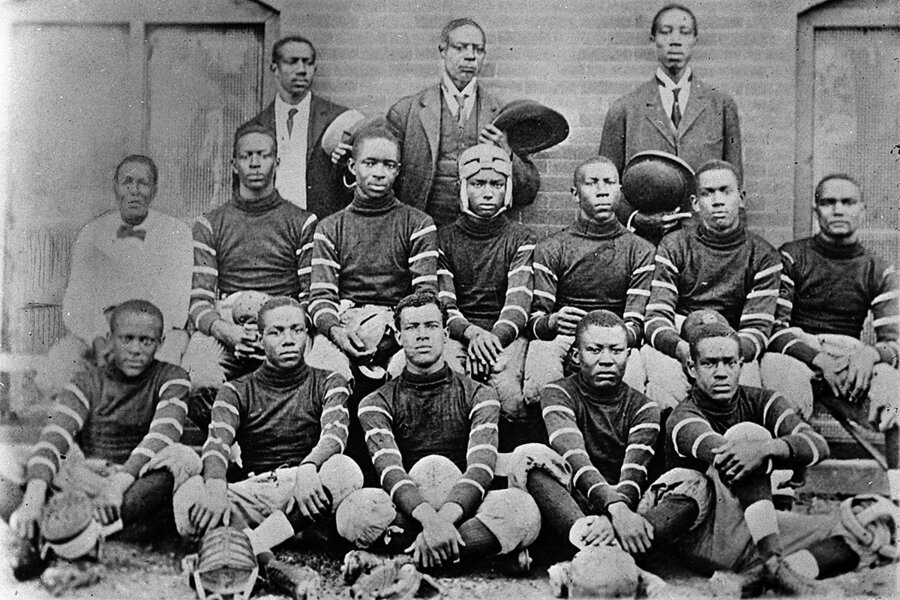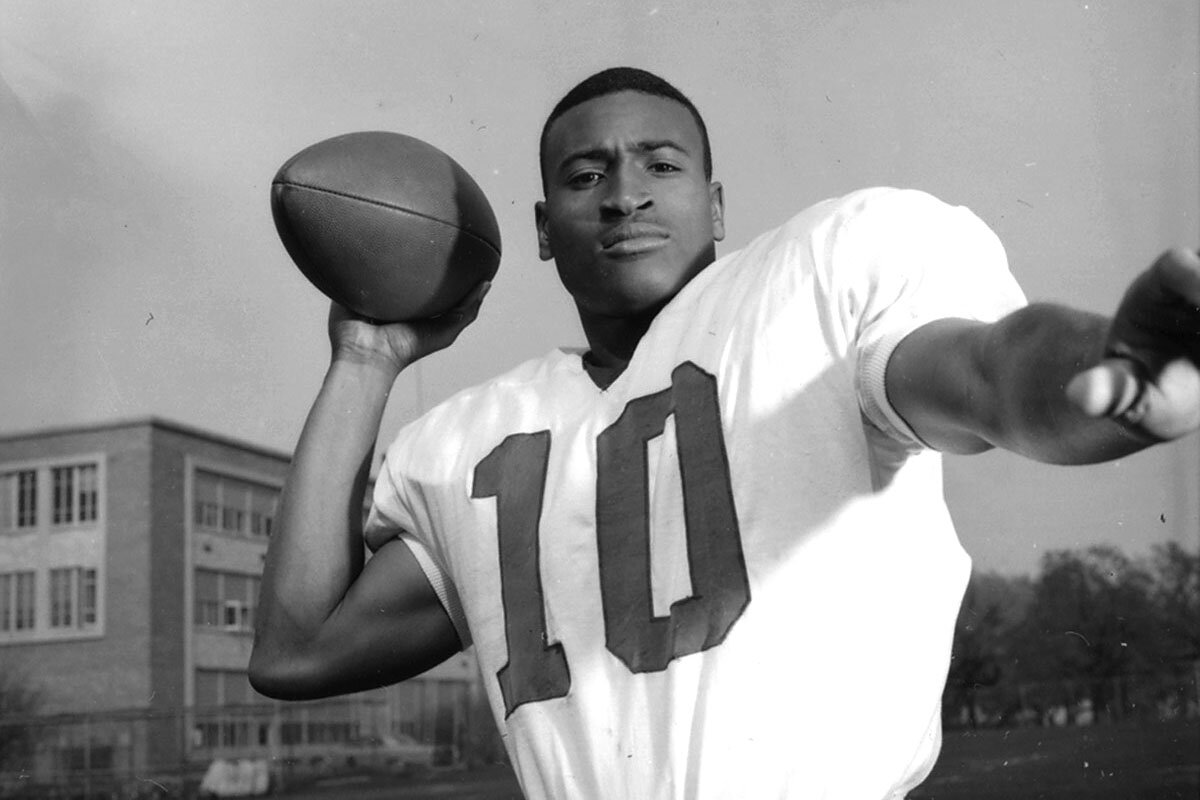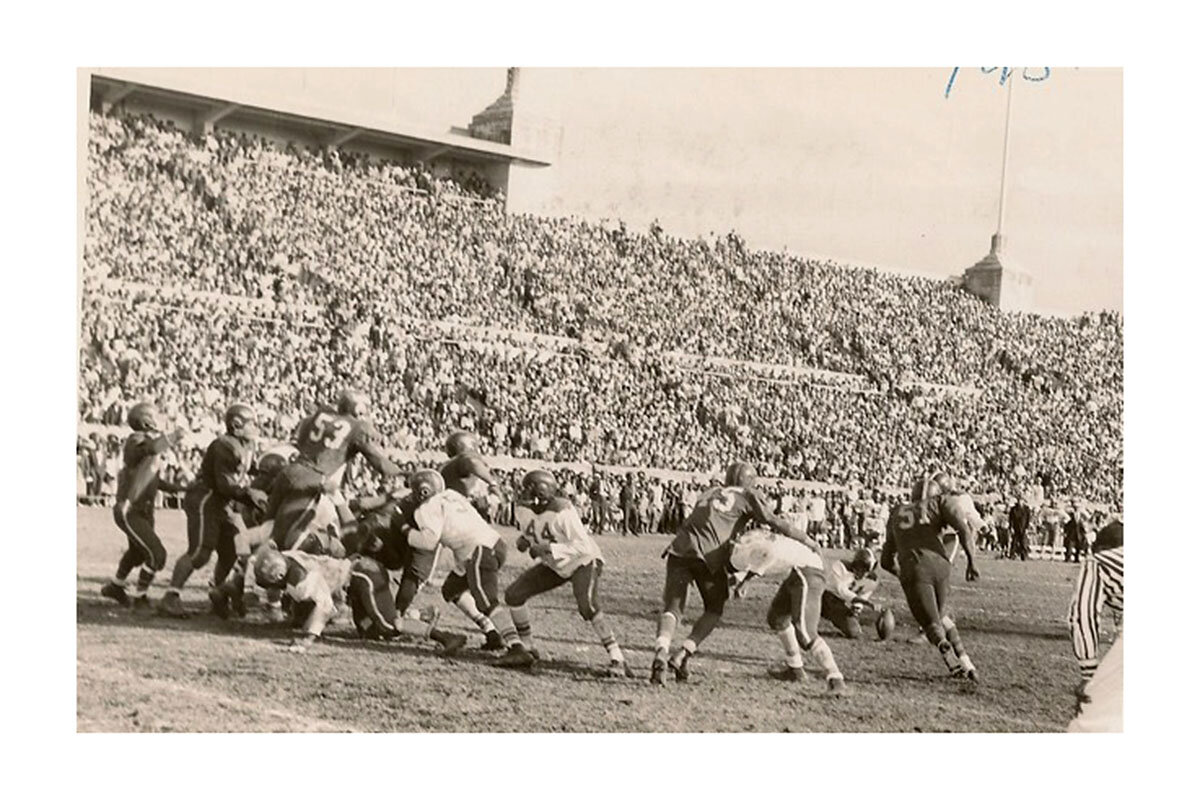Thursday Night Lights: Texas integration offers lessons for NFL debate
Loading...
| San Antonio, Texas
When Thurman Robins thinks of Thanksgiving he thinks of 1954, his ninth-grade year at the all-black Jack Yates High School in Houston, and their annual football game against Phillis Wheatley High School. As was often the case in Texas’s blacks-only high school football league, he saw something that took his breath away.
This time it was Ivory Jones winning the game for Yates with a last-minute field goal – an incident almost unheard of back then, when kickers kicked straight-on with their toes and often missed.
Decades later, November in Texas means the start of high school football playoffs. And this year it means something else as well: the 50th anniversary of the desegregation of high school football in the state.
Though the all-black leagues had celebrated traditions, with integration came the opportunity for black and white athletes to get to know each other in a setting that demanded teamwork and mutual understanding. Today the sport often still reaps those benefits. But it arguably took a hit in the furor over the national anthem protests this season in the National Football League and other sports – at all levels – around the country. Now, some observers are wondering whether a key purpose of integration has been lost, and needs to be rediscovered.
“College and high school sports, when they integrated, it was the first opportunity to sit down and talk to somebody you didn’t normally associate with and find out things beyond the stereotypes,” says Michael Hurd, director of the Texas Institute for the Preservation of History and Culture at Prairie View A&M University in Prairie View, Texas.
“That’s one of the avenues sports facilitates,” he continues. “It always has, and it probably will continue to do so, because [even decades after Jim Crow laws] there’s still some misunderstanding between races.”
A league of their own
At its peak the all-black Prairie View Interscholastic League (PVIL) included 500 schools across Texas. First named the Texas Interscholastic League of Colored Schools, it mirrored the white-schools-only University Interscholastic League (UIL) in almost every way.
The leagues had two schedules, two All-State teams, two state championships. Most black teams used hand-me-down equipment from local white teams, including jockstraps in some cases. Most districts typically only had one stadium as well, so black teams would play on Wednesday and Thursday nights, while white schools would play on the now famous Friday nights.
Over the course of its roughly 40-year history, the PVIL produced a stream of high-quality players, including Eldridge Dickey – the first black quarterback ever drafted in the first round by a professional football team – and Pro Football Hall of Famers Gene Upshaw and “Mean” Joe Greene.
The league also became a cornerstone of African-American culture in Texas, and nothing demonstrates that better than the annual Thanksgiving “Turkey Day Game” between Yates and Wheatley.
“It was a glorious time. All the black Houston community turned out,” says Dr. Robins, author of “Requiem for a Classic,” a 2011 book about the game.
Dressed in suits, ties, and furs – clothes many had saved up all year to buy – people poured out of their homes in the morning for parades. Wheatley fans in purple and white in the Fifth Ward neighborhood, and Yates fans in crimson and gold in the Third Ward neighborhood.
Tens of thousands of people then descended on Jeppesen Stadium in the Third Ward for the game. When the stadium seated just over 20,000, the game sold out. When stadium expanded to almost 40,000 to host the Houston Oilers pro team in 1960, the game still sold out. The game was, according to newspaper reports from the time, the most popular high school football game in the country.
Half-time would the feature cheerleaders and pep squads, as well as the presentation of the “school queens” from Yates and Wheatley. In line with the friendly rivalry on the field, this contest also escalated over the years. One year, a queen arrived in a Cadillac. Then a queen arrived in an antique car. Then a horse and buggy.
Then came the 1958 game, and an act that couldn't be topped: a helicopter buzzed over the field, depositing Yates’s Carolyn Wilkins on the 50-yard line.
“I will have to confess,” Willie Jordan, a Wheatley graduate, told the University of Houston last year, “we threw in the white flag [after that]. Because we were done.”
The football was exciting too. With more laterals, end-runs, and forward passing than the UIL, the PVIL was dynamic and tactically innovative, drawing white coaches and scouts from colleges and high schools across the country.
“Everything was fast, because we had tons of speed,” recalls Robert Brown, who played PVIL football at Lincoln High School in La Marque, Texas, and is now director of the PVIL Coaches Association.
Integration's benefits
Months after the 1954 US Supreme Court decision Brown v. Board of Education ended segregation in US schools, the UIL changed the terms of its membership from “any public white school” to include any school that integrated. But public and legal opposition to the court decision meant Texas schools didn’t fully desegregate until 1967. Yates and Wheatley played their last Turkey Day game in 1966, and the PVIL shut down in 1970.
While no one questions that integration needed to happen, those who remember the PVIL often remember it wistfully. Mr. Brown, who coached at M.C. Williams High School in Houston, through the 1960s, certainly does. But he also saw some of the benefits of integration first hand, and sports were pivotal.
“It’s a magic thing that happens to you. All of your focus, all of your ideas are on winning, winning a district, winning a championship,” he says. “You forget about what color you are when you’re put together on a team.”
Which brings us back to this year’s protests, sparked by NFL player Colin Kaepernick kneeling during the national anthem before pre-season games in August. High school players in Texas have copied the protest, including two players in Crosby, Texas, who were kicked off their team literally moments afterwards as a result.
Mr. Kaepernick began the protest last year to draw attention to “oppressed black people and people of color,” and he has yet to be signed by an NFL team this season. Meanwhile, the fact the protest involved not standing for the national anthem has led many more people to misinterpret the act as a protest against the American flag and the American military.
For Professor Hurd, who recently published “Thursday Night Lights: the Story of Black High School Football in Texas,” that misinterpretation is evidence that despite five decades of integration, black and white Americans still have trouble walking in each other's shoes.
“I think a lot of whites don’t want to stop and give some thought to the real reason these guys are taking a knee, the injustices that still exist, the racism that still exists against people of color,” he says.
Hurd’s father served in World War II as a member of the Red Ball Express, a predominantly African-American truck convoy that served as a key supply route for US troops in Europe. That generation of black veterans returned to a segregated America and were often targeted for lynchings.
“There’s a huge disparity when it comes to patriotism and how it’s applied to black men and the black community in general,” says Hurd, himself a Vietnam veteran. “We’re still seeing the differences in how this country is viewed [by black and white Americans], certainly in terms of patriotism.”
The military helped bridge those two worldviews for Hurd. He went to all-black Worthing High School in Houston, and by the time he joined the US Air Force in 1978 he’d met “probably half-a-dozen” white people. His first roommate in the Air Force was a white guy from Topeka, Kan.
“After lights out we’d just sit and talk for half the night,” he says.
Now, those types of interactions happen among student athletes.
“Getting to know someone who’s not like you,” he adds, “a lot of that happens in team sports.”








